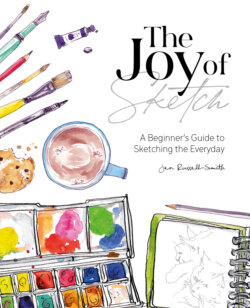Читать книгу The Joy of Sketch - Jen Russell-Smith - Страница 6
На сайте Литреса книга снята с продажи.
ОглавлениеMATERIALS
As with most of my advice, the key message is going to be: do what works best for you! If you’re someone who likes to embark on a project with a perfect array of new tools, then by all means head down to your local art shop and start a collection. But if you prefer not to commit until you’re sure you’ll like it, or have a tendency to ‘save things for best’ and then never use them, I’d encourage you to make a start with whatever you have to hand.
I use waterproof ink and watercolour as my go-to sketching materials and that’s what you’ll primarily see throughout this book. It’s a medium that works well when you’re sketching at speed, so I’d definitely recommend it for anyone short of time or who wants quick results.
Basic
At the most basic level all you need is something to draw with, and something to draw on. Your house will probably already be full of those. Hunt down a ballpoint pen, or whatever you use to scribble notes whilst you’re on the phone. A pencil, felt-tip or even a wax crayon will do for a start. Then an old notebook – even one with lined paper could work – the back of an envelope or electricity bill? If you’ve found a few different tools and papers, a first exercise can be to see which work well together. Wetter ink (felt-tips or ink pens) will bleed on some papers (the ink will spread out and go a bit spidery), which can be a good effect but annoying if you’re trying to create a clean line. Try out a few options to see which work and what you feel the most comfortable with.
I have a jar full of brushes, but probably stick to three favourites 90% of the time
Something to draw with...
A pencil is often the first thing people new to drawing pick up – it’s versatile, you can shade with it easily and, of course, you can rub it out if all goes wrong. But I’m going to encourage you to go straight to a pen. It’ll be daunting at first, but knowing you can’t undo it will actually help you build confidence more quickly – you’ve got to commit to that line from the start! And, of course, it doesn’t matter in the slightest if your first few attempts are a bit bizarre... turn the page and start again.
There are as many different types of pen as you can probably imagine, but if you can track down something with waterproof ink you’ll find it’s extremely versatile. I tend to add watercolour paint to my sketches and you definitely need waterproof ink for that, or it all goes terribly smudgy (a good effect, but only if you want it to happen…). I primarily use a fountain pen (although you’ll spot a few sketches where I’ve tried something different), which I fill with waterproof ink by hand, but that’s quite messy and fiddly and not necessarily what I’d recommend when you’re starting out. Most ballpoint pens are automatically waterproof, and most pen shops (you don’t need an art-specific one – a general stationers will be fine) will have a range of fine-liners or rollerballs with waterproof ink.
Paint
As with pens, there are many different types of paint. I predominately use watercolour and that’s what I’m going to focus on here, but feel free to try other types of paint if something catches your eye or interest.
You can easily pick up a basic watercolour palette from most art or stationery stores – they’re brilliant as they’re portable, easy to clean and easy to mix. Most also come with a brush so, assuming you have an old jam jar, washed-out yoghurt pot or similar for your water, you’ll have everything you need.
Paper
The wetter you’re going to get your paper, whether with paint or ink, the thicker it will need to be. You can buy specific watercolour paper which won’t buckle if you soak it, but standard cartridge paper will cope with a little bit of watercolour quite happily. Have a look over the page for a bit more information about paper and notebooks.
Other materials
Art shops are pretty much an Aladdin’s cave of interesting and intriguing materials. Some things you might want to consider if you want to branch out could include masking fluid (for keeping the watercolour off areas of your paper), sponges and different brushes for different effects, and various types of paper etc. But all those are very much optional extras, and not anything you’ll need to make a start. Keep an eye out for my ‘Take it further’ suggestions for next steps with materials.
